Ice playgrounds
Along rivers and lakes, it's fun to hang out with Jack Frost.

© Beth Gauper
In winter, ice comes with the territory. You can curse it — or you can play with it.
Kids know how. Climbers and skaters know how. And photographers adore it.
Having fun with ice also is a good way to cope with a winter that drags on, endlessly, into April.
That's when gigantic heaps of shards pile up on Lake Superior and ice storms create glistening tableaux that make photographers come running.
Once, I considered ice the mere byproduct of conditions too poor to produce snow. That was before I really looked at it. On north-woods rivers and lakes, ice glazes snow into all kinds of magical shapes.
One year, after an ice storm turned northern Wisconsin ski trails into screaming luge runs, I cut short a ski weekend and headed home through glazed forest. But Amnicon Falls State Park was on the way, so I stopped to explore.
In the summer, the Amnicon River is a jolly little stream that tumbles over a series of waterfalls as it splits around a wooded island.
In winter, the river is frozen in place and the park is silent, but there's a palpable sense of suppressed energy, straining under the opaque marble pillars that once were rushing torrents.
As I made my way along the shore, admiring ice formations, nothing moved. Then, I noticed what appeared to be a heap of ashes at the base of Snakepit Falls.
It was heaving and sighing as if an asthmatic giant were lying just underneath, puffing life into this Mount St. Helens on ice.
I was itching to touch it but afraid to get too close, so I fetched a long stick and gave it a poke. Poof — my little volcano turned out to be nothing but frozen foam, quickly scattered to the wind.
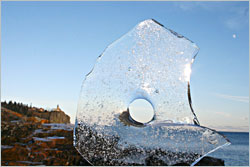
© Beth Gauper
Ice is strange. A whisper of wind or droplet of mist is all it needs to shift shapes — and, like snowflakes, it never takes on the same shape twice.
Now, I consider a good icescape to be a main destination. My favorite is the Apostle Islands National Lakeshore ice caves on Wisconsin's Bayfield Peninsula. I visit them every year that Lake Superior freezes enough to allow people to walk along its shores.
Gooseberry Falls on Minnesota's North Shore always is worth a stop for its filmy curtains of icicles, which create niches and tunnels children love to explore.
All of the North Shore rivers are gorgeous. Walking on the shallow Kadunce near Grand Marais, I once spied elfin strings of tea lights strung under thick slabs of snow. On the nearby Brule, shiny minarets topped flowing tapestries of ice.
If it's near water, any summer playground is even more fun in winter: A pile of ice is a jungle gym, swing set and merry-go-round all rolled into one.
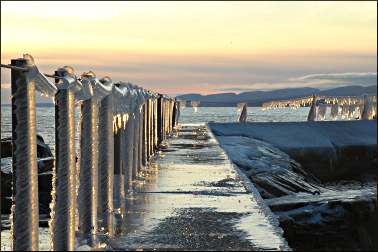
© Torsten Muller
Art at Artists' Point
Late one winter, I went out to Artists Point in Grand Marais, popular in summer for its piles of cobblestones that can be stacked into cairns and arches. But in winter, there was more to play with.
On the village side of the point, thin slices of ice lay in pointy heaps that mimicked the Sawtooth Mountains rising behind the village; they were so transparent, I lifted one to my camera and used it as a filter.
On the lake side, chunks of ice were strewn like Lucite paperweights. One was in the shape of Minnesota, its southern half a skein of tiny fractures, and its northern half so clear it refracted the sun into dancing rays of purple, yellow and blue.
Usually, wind and snow make surfaces rounded and dull, like jade.
But on this day in Grand Marais, the ice was as sharp-edged and clear as art glass, and walking on the beach was like walking through a gallery: I spotted a Picasso hen, a Chihuly chandelier, an Orrefors vase.
On the bay, craters of ice rode the waves like jellyfish, bashing each other's edges into tinsel. But in the harbor, the water was unnaturally motionless — only the presence of gulls, sitting just a little too high, gave away the fact that it was frozen.
I could have played there all day, examining each piece as if it were the rarest thing in the world. I wanted to take some home, but there's no such thing as a souvenir from an ice field.
But the memories will last for a long time.

© Yooper Steez
Trip Tips: Northwoods ice playgrounds
Anywhere there's water and rock, there will be ice formations.
Always be careful when walking on rivers and lakes; to be safe, ask a local naturalist for advice, bring a buddy and carry a stick that you can tuck under your arms horizontally if you fall in.
Thick snow is no guarantee of safety; it's an insulator and may be keeping water from freezing.
For safety, wear spikes or other traction devices on your boots. For recommendations, see Walking on ice.
Formations are most delicate when the air is very cold, but the sunnier days of late winter, until the ice breaks up in late March or early April, are a perfect time to play.
MINNESOTA
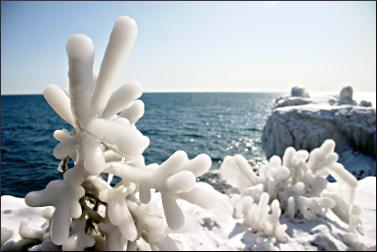
© Beth Gauper
Tettegouche ice forest
On Minnesota North Shore, the Tettegouche State Park campground along Lake Superior often becomes a magical ice forest after storms, when waves splash up and over the cliffs, glazing tree branches and bushes.
Artists' Point in Grand Marais
This wooded spit of land on the east side of the harbor, beyond the U.S. old Coast Guard station, is fun to explore in any season.
For more, see our Facebook album.
Stoney Point near the Knife River
Fifteen miles from Duluth on old Minnesota 61, waves slam this part of the North Shore, pushing enormous slabs of ice into piles.
Surfers ride the biggest waves, and storm-watchers come to watch them pound tractor-sized boulders along the shore.
It's just past the New Scenic Cafe. Turn onto Stoney Point Drive. For more, see Minnesota's scenic 61.
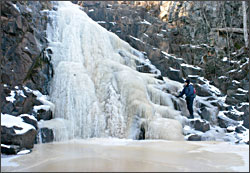
© Beth Gauper
North Shore rivers and waterfalls
Gooseberry Falls State Park is a favorite place to clamber around, with dramatic, varied ice terrain.
The water around Lower and Middle Falls isn't too deep, but be careful around Upper Falls, which has a 20-foot pool at its base.
For more, see Gooseberries on ice.
Four miles east of Gooseberry at the mouth of the Split Rock River, a five-mile hiking trail goes up the west side of the river and crosses a bridge to return along a ridge and back to the highway.
Not far from the start, there's a 20-foot waterfall around the corner from the first bridge.
A few miles down the road, the cove below the famous Split Rock Lighthouse is a fun place to play on the rocks.
Past Lutsen, there are many formations on the rapids and falls of the Cascade River.
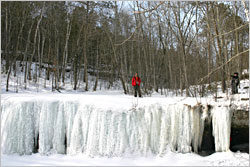
© Beth Gauper
Past Grand Marais, the first sections of the Devil Track and Kadunce rivers can be traversed in winter, through picturesque red gorges dripping with icicles.
For more, see Snowshoeing river canyons of the North Shore.
For distances, see North Shore by the mile.
Banning State Park near Sandstone
Banning is right off Interstate 35, halfway between the Twin Cities and Duluth.
It's a lovely snowshoe hike to Wolf Creek Falls, near the Kettle River. There aren't caves, but you can walk behind an impressive icefall.
WISCONSIN
Amnicon Falls State Park
The falls in this state park, 10 miles east of Superior on U.S. 2, are very easy to explore. A covered bridge allows access to the island, which is encircled by a series of frozen rapids.
Northwest Wisconsin waterfalls
Thirteen miles south of Superior, Pattison State Park has the fourth-highest waterfall east of the Rockies and is easily reached.
For more, see Waterfalls of northern Wisconsin.
Apostle Islands National Lakeshore ice caves

© Beth Gauper
The mainland ice caves, four miles east of Cornucopia off Meyers Beach Road, are magnificent — like an underground cave turned inside out, except that many of the formations are in delicate hues of blue and green.
However, Lake Superior doesn't always freeze hard enough to allow the one-mile walk from the Meyers Beach parking lot. In fact, it hasn't frozen hard enough to allow mass travel to the caves since 2014.
For more, see Ice caves of the Apostles.
An option would be to walk or snowshoe the Lakeshore Trail along the cliff top, which goes to the caves from Meyers Beach. Be sure to keep a good grip on kids.
MICHIGAN'S UPPER PENINSULA
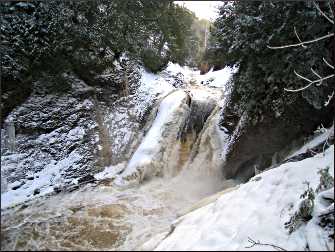
© Beth Gauper
Black River waterfalls near Bessemer
This is the top destination of Patrick Lisi, a Wisconsin game warden whose book "Wisconsin Waterfalls" is the bible for waterfall watchers.
From Bessemer, eight waterfalls tumble down the Black River as it heads toward Lake Superior. They're along the North Country National Scenic Trail and off County Road 513.
For more, see Waterfalls by snowshoe.
Pictured Rocks National Lakeshore
Between Munising and Sand Point, there are several ice columns and curtains that form "caves," as well as frozen waterfalls.
Along Sand Point Road, park in the lots at Sand Point Beach or Munising Falls and walk to the formations. It's a good idea to bring ice cleats.
Eben Ice Caves near Pictured Rocks
The Eben Ice Caves form in the Rock River Canyon. They're southwest of Au Train, about six miles from Lake Superior. It's a mile round-trip on well-packed snow.
Again, bring ice cleats for exploring the caves.